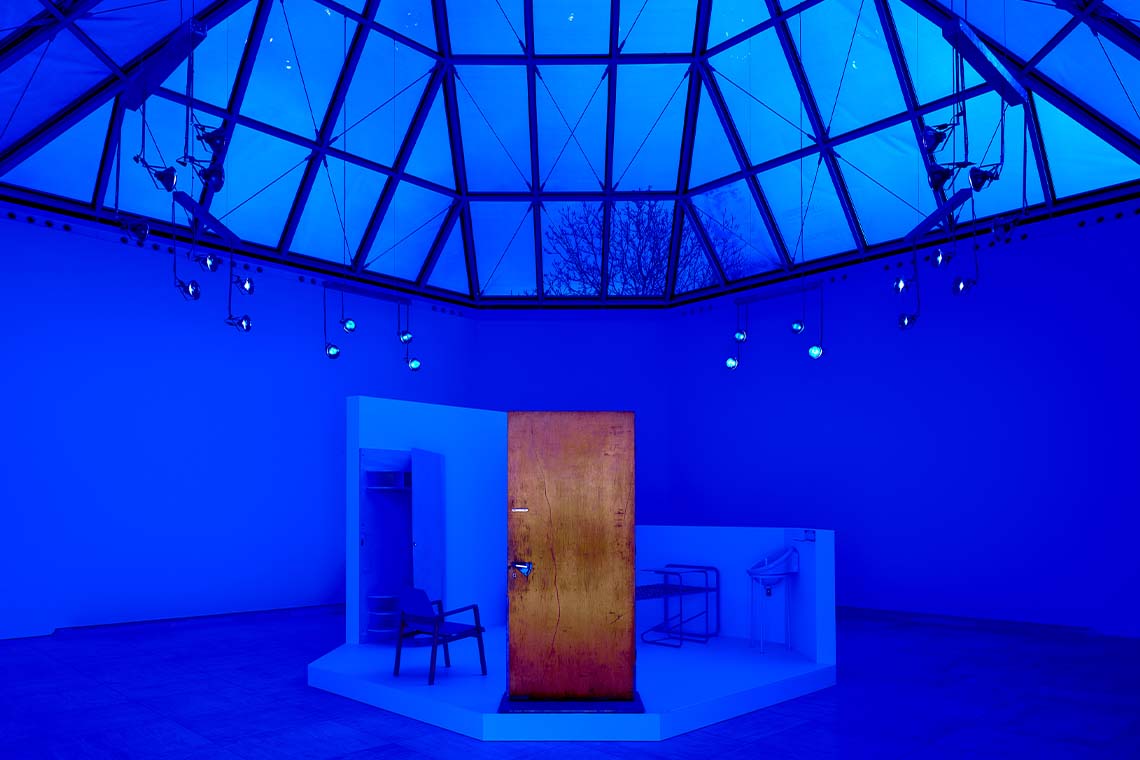A memorial to Lebanon’s historic tragedies, Rayyane Tabet’s A Model: Prelude, specially conceived for his solo exhibition at Mudam Luxembourg, transforms trauma into hope.
With every act of violence, a ripple of impacts travels far beyond the epicentre. These repercussions often go undocumented, remaining invisible to outside observers, but can leave a legacy that lingers far beyond the singular initial trauma and one which might even carry positive or poetic qualities.
When on 4 August 2020 a warehouse of ammonium nitrate stored in the Port of Beirut exploded, resulting in 218 deaths and 7000 injuries, the shockwaves spread for miles across the city, damaging buildings and smashing windows on the way. Environmental engineer and political activist Ziad Abichaker began collecting this glass from buildings all over Beirut, sending it to glassblowers in the north of Lebanon who were struggling to source raw materials thanks to continual currency devaluations. They transformed the glass from the explosion debris into traditional glass water pitchers, transforming a violent act into a simple gesture of solidarity that can help new resonances emerge.
Two hundred of these clear glass jugs are now arranged in a floor-to-ceiling stacking system at Mudam, the modern art museum of Luxembourg. Each item is similar but unique, due to the handcrafted process, and formed of glass containing a million stories of disaster, loss and devastation. They are equally functional, beautiful, and testament to a social response.

They were put in place by Rayyane Tabet as part of his Trilogy project for the museum, a series of discrete interventions into the I M Pei-designed building which a visitor encounters sequentially. “I constantly came back to all these windows,” Tabet tells Canvas while sitting under one of Pei’s vast glass roofs which cover Mudam, “both the strength and vulnerability of it.” For an artist that responds to contexts and sites, these led to a series of memories rooted to the notion of windows: “three moments that I call window treatments, coming from personal, local and regional experiences from Lebanon.”
The series of interventions takes place in the pavilion, a discrete part of Pei’s design separated from the main museum by an internal glass-walled bridge. Tabet has narrowed that passage and occluded the vast view across Luxembourg by hanging gauze curtains along its length. “When my grandparents married in 1950, they had no money to move into their own apartment, so they moved in with my great grandparents,” he explains, adding that “they didn’t have to buy anything, but my grandmother was only allowed to change one thing in the apartment and she decided to replace all the 1920s dark velvet curtains with a 1950s lightweight, sheer fabric.” These curtains now hang in Mudam, retrieved from storage and poetically combining to perfectly fill the bridging corridor to the pavilion.
The curtains have personal resonance, but their very material also carries trauma. Tabet explains that their fabric is “a combination of rayon, nylon and polyester, a material rooted in technologies developed during the First World War to produce cheaper alternatives to cotton for use in clothes for soldiers”. The artist goes on to explain how the material became commercially available for Lebanese middle-class families, but took on a more sinister character during the Second World War, when “the Nazis made cheap and accessible rayon fabrics using forced labour.”
The white gauze shimmer’s in Luxembourg’s cold winter light, but the curtained route draws the visitor’s gaze deep into the pavilion space which is glowing in a rich blue light. Upon entry, the second of Tabet’s window treatments is visible, the artist having covered the extension’s glass roof with blue coloured panels, turning the entire space into monochromatic haze. A beautiful experience, but one also rooted in trauma – here 1967’s Six Day War is invoked.

“All over the Arab world, a curfew was imposed and people had to turn off their lights at night to hide structures from bombing,” Tabet explains, adding that it was quickly realised that a blue tint also reduced visibility from planes. Consequently, windows and car headlights were washed over with an indigo powder blueing agent to circumvent the curfew, the artist saying that “I had this imagination of how during those six days the entire Arab world fell into a deep blue darkness.”
In the centre of the octagonal space sits Alvar Aalto’s furniture for his 1933 Paimio Sanatorium, items that Mudam had held in storage since acquisition in 2000 but never exhibited. Tabet was drawn to the items in part because of the gesture of shedding light on what had been hidden away in the storerooms, but also because of their interwar genesis, a moment post- and pre-trauma in which society sought to repair and build a new future from that which had collapsed.
A circular stairway takes the visitor away from the blue light, and into the lower space of the pavilion. Here, the grid of glass pitchers stands alone, the brightness of the space contrasting with the blue left behind, shimmering through the translucent glass shaped by generations of passed-down techniques. In this illuminated silence, in a room with no windows, there seem to be 200 windows into lost lives, impacted families, civic destruction – but also senses of resilience, restoration and repair.



